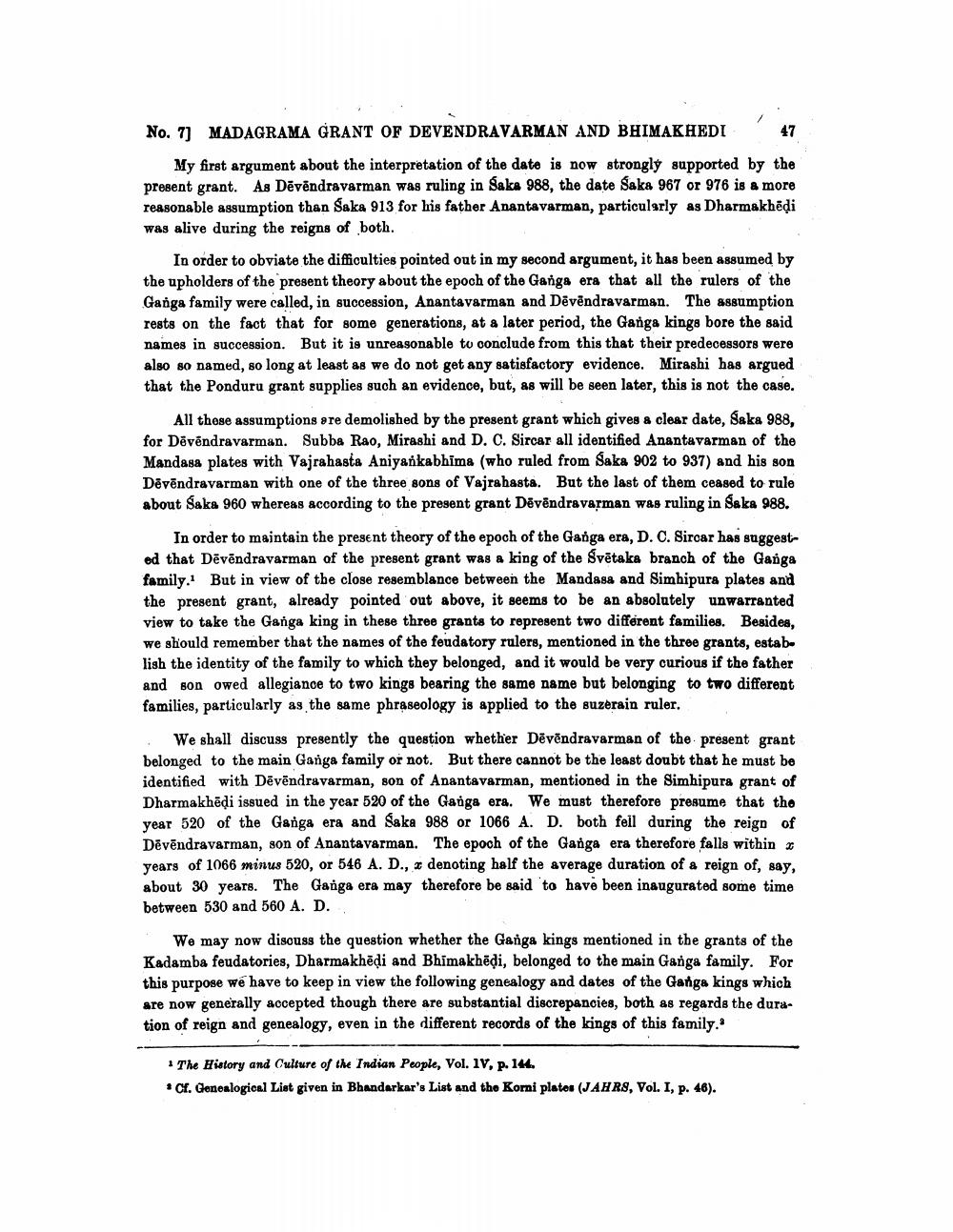________________
No. 7] MADAGRAMA GRANT OF DEVENDRAVARMAN AND BHIMAKHEDI : 47
My first argument about the interpretation of the date is now strongly supported by the present grant. As Dēvēndravarman was ruling in Saka 988, the date Saka 967 or 976 is a more reasonable assumption than Saka 913 for his father Anantavarman, particularly as Dharmakhēļi was alive during the reigns of both.
In order to obviate the difficulties pointed out in my second argument, it has been assumed by the upholders of the present theory about the epoch of the Ganga era that all the rulers of the Ganga family were called, in succession, Anantavarman and Dēvēndravarman. The assumption rests on the fact that for some generations, at a later period, the Ganga kinga bore the said names in succession. But it is unreasonable to conclude from this that their predecessors were also so named, so long at least as we do not get any satisfactory evidence. Mirashi has argued that the Ponduru grant supplies such an evidence, but, as will be seen later, this is not the case.
All these assumptions are demolished by the present grant which gives a clear date, Saka 988, for Dēvēndravarman. Subba Rao, Mirashi and D. C. Sircar all identified Anantavarman of the Mandaga plates with Vajrahasta Aniyankabhima (who ruled from Saka 902 to 937) and his son Dēvēndravarman with one of the three sons of Vajrahasta. But the last of them ceased to rule about Saka 960 whereas according to the present grant Dēvēndravarman was ruling in Saka 988.
In order to maintain the present theory of the epoch of the Ganga era, D. C. Sircar has suggested that Dēvēndravarman of the present grant was a king of the Svētaka branch of the Ganga family. But in view of the close resemblance between the Mandasa and Simhipura plates and the present grant, already pointed out above, it seems to be an absolutely unwarranted view to take the Ganga king in these three grants to represent two different families. Besides, we should remember that the names of the feudatory rulers, mentioned in the three grants, establigh the identity of the family to which they belonged, and it would be very curious if the father and son owed allegiance to two kings bearing the same name but belonging to two different families, particularly as the same phraseology is applied to the suzerain ruler.
We shall discuss presently the question whether Dēvēndravarman of the present grant belonged to the main Ganga family or not. But there cannot be the least doubt that he must be identified with Dēvēndravarman, son of Anantavarman, mentioned in the Simhipura grant of Dharmakhēdi issued in the year 520 of the Ganga era. We must therefore presume that the year 520 of the Ganga era and Saka 988 or 1066 A. D. both feil during the reign of Dēvēndravarman, son of Anantavarman. The epoch of the Ganga era therefore falls within years of 1066 minus 520, or 546 A. D., 3 denoting half the average duration of a reign of, say, about 30 years. The Ganga era may therefore be said to have been inaugurated some time between 530 and 560 A. D.
We may now discuss the question whether the Ganga kings mentioned in the grants of the Kadamba feudatories, Dharmakhēdi and Bhimakhēļi, belonged to the main Ganga family. For this purpose we have to keep in view the following genealogy and dates of the Ganga kings which are now generally accepted though there are substantial discrepancies, both as regards the duration of reign and genealogy, even in the different records of the kings of this family.
* The History and Culture of the Indian People, Vol. 1V. p. 144. *Cf. Genealogical Liat given in Bhandarkar's List and the Komi platos (JAHRS, Vol. I, p. 46).




